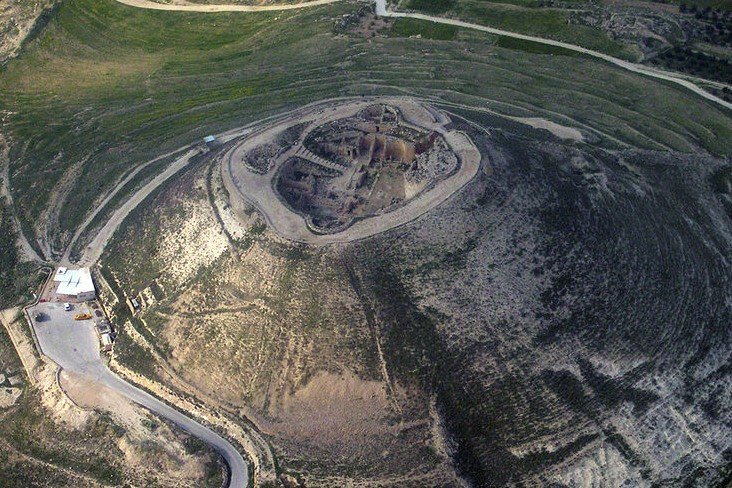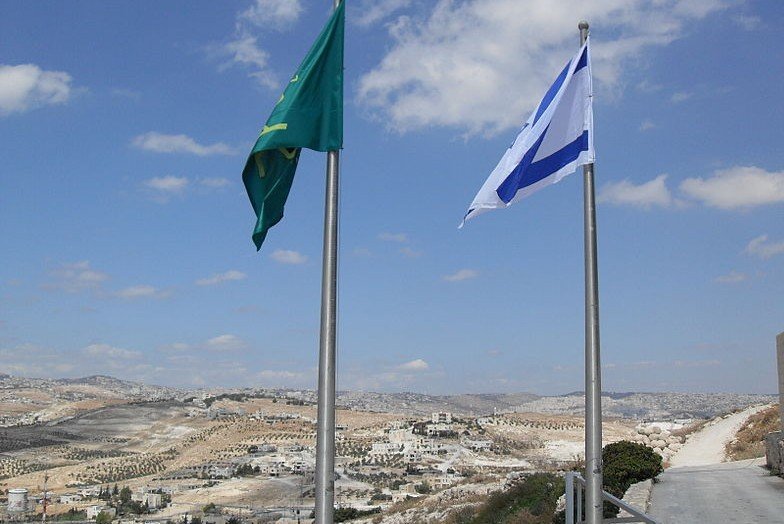“Herodium is a major archaeological site, home to an impressive palace dating to the time of King Herod.
“Herodium is a major archaeological site, home to an impressive palace dating to the time of King Herod. Located about 10km south of Jerusalem, the site was also the burial location of Herod, hence the tumulus shape of the hill. Herodium is known as “Mountain of Franks” or “Jabal al-Fourdis” the “Mountain of Paradise”.”
The impressive mound that is Herodium. Image wikicommons
Although Herod was a ruthless leader who represented Rome in Judea between 37BC and 4BC he was also a visionary and responsible for many of Israel’s most architecturally advanced structures which have survived. He was responsible for among other projects the Second Temple in Jerusalem, the palace-fortress on Mount Masada, and the impressive port of Caesarea.
Herodium required the reshaping of the hilltop and the labor of many slaves and artisans to produce not only a pleasure palace but a fortified safe haven for the ruler. Nearby springs were channeled to supply water to the Herodium’s aqueduct system, water the gardens and supply water to an enormous pool which took pride of place on the hilltop. Within the complex were courtyards, palatial halls, and chambers. From the elevated position of the palace, there are panoramic views across Bethlehem, Jerusalem and the Judean Desert.
THINGS TO SEE AT HERODIUM
The Palace – This elaborate construction once had seven levels with towers at the four corners. The fortress/palace was built by creating two cylindrical concentric walls and then filling them with earth.
The Bathhouse – There are still remains of the bathhouse consisting of a changing room, stretching room, steam room, and cold bathroom. The bathhouse was richly decorated with mosaic floors and frescos on the walls.
Synagogue – Once the Herodium had been taken over by the Jewish rebels in the Great Revolt they converted what was probably a dining room into a synagogue. Later during the Bar Kokhbar Revolt of c.132AD-135AD the fighters dug tunnels through the manmade hill.
 Flags at Herodium. Image wikicommons
Flags at Herodium. Image wikicommons
Churches – Following the Jewish occupation of Herodium Christian monks spent time at the site and three churches have been uncovered on the site with mosaic floors.
Mausoleum – Herod’s two storey mausoleum was uncovered with an intricately decorated limestone sarcophagus believed to belong to Herod.
Tunnels – The tunnels hewed by the Jewish rebels during the Bar Kokhba Revolt are lit and can be entered by visitors.
VISITING HERODIUM
A private Herodium and Judean Desert Eco-Experience Tour can be arranged any day of the week.
Visiting Herodium on your own takes around 1-2 hours. There are guided tours in Hebrew on Fridays and Saturdays and English tours can be arranged.
The site is accessible from the Har Homa-Teko’a-Nokdim Road #356 about 2km before the Teko’a junction, where you will see signs directing you to the Herodium.
Related Post
The entire tomb is filled with signs and symbols that mention Queen Nefertiti and after some time passed and linguistic experts managed to decipher the stories told here, the team was baffled.
The mystery of the Solar Temple of Abu Gurab and its “Star Gate” comes to light
Thuya, the mother of Queen Tiye, left a monumental legacy by becoming the grandmother of Akhenaten and Tutankhamun.
The oldest traditions lead us to believe that blacks were the first inhabitants of Mexico.
The REAL face of King Tut: The pharaoh had feminine hips, clubfoot, and protruding teeth according to the ‘virtual autopsy,’ which also revealed that his parents were brother and sister.
The “oldest gold of humanity” was found in the Varna necropolis, on the Bulgarian Black Sea coast

